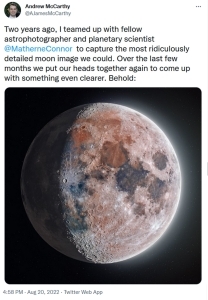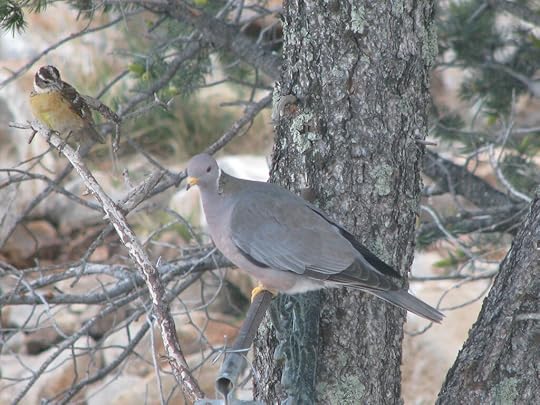Kate Rauner's Blog, page 14
September 16, 2022
That’s What I Call Computer Support! Voyager 1 is back #NASA #space
A computer from the mid 1970s had a glitch. If this was my machine, I’d be doomed, because who supports such old equipment? NASA does! At least, it does for the Voyager spacecraft. Even when the probe is 15 billion miles away, outside our Sun’s influence, traveling through the interstellar medium.
In May, 2022, Voyager 1 began reporting weird, garbled nonsense instead of telemetry data. Luckily, the radio signal from the ship remained strong and steady, which meant the antenna was still pointed at Earth, so NASA got to work. inverse.com
Voyager actually has multiple ancient computers. One croaked years ago, but somehow got switched on again and was corrupting the outgoing data. NASA engineers sent a command to use the correct computer, and proper data is again arriving at Earth. They hope to figure out exactly what caused Voyager to switch computers in the first place, so the problem doesn’t return. Could have been cosmic radiation…
 In December 2004, Voyager 1 crossed the termination shock, where the solar wind is slowed to subsonic speed. In 2010, the outward velocity of the solar wind dropped to zero, but the transition to interstellar space was not smooth. The zone is filled with giant magnetic bubbles (surprise!)
In December 2004, Voyager 1 crossed the termination shock, where the solar wind is slowed to subsonic speed. In 2010, the outward velocity of the solar wind dropped to zero, but the transition to interstellar space was not smooth. The zone is filled with giant magnetic bubbles (surprise!)There’s lots more about the decades-long Voyager 1 mission on Wikipedia: click here.
September 14, 2022
The Moon Like Never Before #moon in enhanced reality and in #sciencefiction
Two years and 200,000 frames in the making! The Moon like you could see it if your eyes were more sensitive.
 Thanks Science Alert
Thanks Science Alert
See the Moon tinged red and gunmetal blue, illuminated on the right-hand side as it faces Earth. The red patches are iron and feldspar oxidized by errant oxygen atoms from Earth, McCarthy explained to inquisitive viewers on Twitter.
Though the colors may look false, they are technically the Moon’s true hues, only that our eyes are not sensitive enough to see them, and so McCarthy gave the image a saturation boost to bring out the colors in all their glory.
Reality is more awe inspiring than fiction, but if you want to travel to the Moon today, science fiction will give you a lift. The final kindle in my trilogy, Winnie Bravo, Space Pilot will be released tomorrow. That’s also the last day for the special launch price of 99 cents per kindle for each book. Hurry and claim your copies: click here now.
Outside the USA? Here’s your link to click on.
Humanity’s future in space depends on audacious pilots, and it may help if they’re a bit crazy.
 Click here now for Book 3, the gripping conclusion
Click here now for Book 3, the gripping conclusionWinnie Bravo is brash, reckless, and more than a little annoying as she sets out to prove herself, careening from adventure to adventure with her partner Bertie never far away.
In orbit, across the Moon, and on Earth, she pursues the truth about a nefarious probe and a scoundrel who will stop at nothing. What she discovers brings her closer to the truth than she bargained for, and may get her killed, or worse, fired.
If you love traveling to the future for rollicking adventures, you won’t be able to put Winnie’s story down. Binge on through, because the complete trilogy is available.
Available in Kindle, paperback, hardcover, and Kindle Unlimited
September 11, 2022
Asteroids Skim By Earth #asteroid #science #scifibooks
NASA tracks asteroids! See thousands plotted on a diagram of the solar system by clicking here. But you’re most interested in those that pass close by Earth, aren’t you? Two are passing us September 11th, and an even bigger one September 12th.
The Asteroid Watch dashboard tracks asteroids and comets that will make relatively close approaches to Earth. The dashboard displays the date of closest approach, approximate object diameter, relative size and distance from Earth for each encounter. JPL/NASA Next Five Close Approaches
Holy smoke. A rock at least the size of an ordinary commercial jet that comes close – within 20 times the distance to the Moon – is potentially hazardous. While NASA can predict an asteroid’s current path, the calculations are complex, affected by all the planets, and things change thanks to collisions with other space rocks. Small bits of space debris rain down harmlessly on Earth every day, but someday, one of these big ones will hit, causing massive destruction.
Or not.
Maybe we can protect ourselves.
NASA’s Double Asteroid Redirection Test (DART) spacecraft just beamed back the first image of its target, the moonlet Dimorphos, as well as its body it orbits, the asteroid Didymos. DART is a planetary defense test mission designed to impact the moonlet to alter its trajectory around Didymos. If proven effective, this spacecraft design could potentially be scaled up to deflect an Earth-bound asteroid. space.com
Asteroids skip safely past Earth so often, even the media can’t maintain a state of panic. Hopefully, we have time to create Earth defenses.
In the meantime, science fiction shows us what could happen. Asteroid is the second book in my Winnie Bravo, Space Pilot trilogy. If a future space industry brings asteroids into lunar orbit, what could possibly go wrong? Click here now and join the adventure.

Special price through September 15th for all three kindles! Only 99 cents each, so claim your copies today. Click here now and don’t miss out.
Humanity’s future in space depends on audacious pilots, and it may help if they’re a bit crazy.
Winnie Bravo is brash, reckless, and more than a little annoying as she sets out to prove herself, careening from adventure to adventure with her partner never far away.
In orbit, across the Moon, and on Earth, she pursues the truth about a nefarious probe and a scoundrel who will stop at nothing. What she discovers brings her closer to the truth than she bargained for, and may get her killed, or worse, fired.
September 9, 2022
Is Life on Earth a Subset of Lyfe? We won’t know unless we expand our horizons #Mars #biology #space
As we explore the solar system, one of the things we’d most like to find is alien life. But with life on Earth as our only an example, what will we miss?
 Searching on Mars – but, for what, exactly?
Searching on Mars – but, for what, exactly?That’s why new research supported by Nasa’s astrobiology programme has developed a novel and broader definition of life – a definition that encapsulates life on Earth but also the possibility of “life not as we know it” elsewhere on the board. They call it lyfe. The Guardian
We’re hoping to find lyfe – current or fossilized – on Mars, and also suspect the cold ice-crowned oceans of the outer solar system moons could contain their own denizens. But if we don’t free our imagination, we could step right over a lyving being without seeing it, and the line between alyve and not could be hazy. So what is lyfe?
A “lyving” organism will satisfy four criteria: dissipation (the ability to harness and convert free energy sources); autocatalysis (the ability to grow or expand exponentially); homeostasis (the ability to limit change internally when things change externally); and learning (the ability to record, process and carry out actions based on information). With this definition, life is just one specific instance of lyfe. The Guardian
The words we use restrict our thoughts, so I like this new sciency word. For more sciency words, including this week’s post on life (or lyfe) visit one of my favorite sites: Click here for Sciency Words: Flora and Fauna.
Thanks to NASA for their open access article, Defining Lyfe in the Universe.
September 7, 2022
Making Oxygen on Mars – It Works! #space #mars #real-life #scifibooks
NASA’s Mars 2020 mission and Perseverance rover may be best known for the plucky little helicopter that hitched a ride to become the first aircraft on another world, but the excitement doesn’t stop there.
 Credit: NASA/JPL-Caltech
Credit: NASA/JPL-CaltechOn the red and dusty surface of Mars, nearly 100 million miles from Earth, an instrument the size of a lunchbox is proving it can reliably do the work of a small tree, successfully making oxygen from the Red Planet’s carbon-dioxide-rich atmosphere since April 2021. MIT.edu and Science Advances
Martian explorers will need oxygen to breath and for fuel systems, such as in a rocket to return them to Earth. That’s not the end of the story, of course. Earthly air is 78% nitrogen, but as an inert gas, once a habitat is filled, the nitrogen should be permanent (baring a leak… more possible trouble.)
But… Yee Ha!
“This is the first demonstration of actually using resources on the surface of another planetary body, and transforming them chemically into something that would be useful for a human mission,” says Jeffrey Hoffman, a professor at MIT’s Department of Aeronautics and Astronautics.
Take a deep breath, Mars lovers. Someone, someday, will be able to breath O2 made this way on Mars.

Until crewed missions to Mars became available, you can only travel there in science fiction. Check out my scifi series that starts with humanity’s first near-future toe-hold on the vast Tharsis Plain and goes on through generations. Join a different settler in each book. Each one strives to build a life on Mars, but first they must survive.
Find the books at your favorite on-line store. Click here for Book 1 or click here to buy the entire series in a value-priced box set.
September 2, 2022
Gifted with an Asimov Classic :) #scifibook #robots #sciencefiction
 My elder-statesman cat, Harvey, examines the classic book. Such finds make haunting used-book sales worthwhile.
My elder-statesman cat, Harvey, examines the classic book. Such finds make haunting used-book sales worthwhile.Lucky me! Adeena Mignogna gifted me with a book of short science fiction tales. This classic published in 1957 contains stories from the Golden Age, over a dozen of Asimov’s short pieces, all set on Earth. There’s no need to wander the galaxy when Earth is Room Enough. Thanks, Adeena.
Surely you know Isaac Asimov!
You can’t claim to be well-rounded in science fiction if you haven’t read Foundation – a collection of stories written between 1941 and 1949, and assembled into a book in 1951. The second and third volumes followed quickly. This was the Golden Age, and the trilogy’s been called the beginning of modern science fiction, and the greatest scifi series ever. I’m sure this second accolade will be debated until the sun burns out. From my own review of Foundation
Asimov’s’ stories are heavy on concepts and light on actual story. If you read one musing a month in the era’s ‘zines, each was probably fascinating. To sit down today, when many of the tropes he invented are commonplace, reading straight through may not be the best plan. But short stories are already in bite-sized pieces, so I know what book I’ll be curling up with tonight.
Adeena is the author of a fun clean scifi read – one suitable to share with all ages. Check out my recommendation here or click straight to Amazon to find Adeena’s book. These delightful robots suffer from technical glitches that are slowly destroying them, but they’ve found a human who can save them – if she’s willing.

August 26, 2022
Return to the Moon Takes Another Step Forward #NASA #Artemis #moon
NASA is headed for the Moon.
NASA’s huge Artemis 1 rocket is counting down to a planned Aug. 29 launch to the moon and when it does, you’ll be able to watch the historic mission live online for free. NASA
A megarocket will launch an uncrewed mission as the next step to astronauts returning to the Moon. Videos leading up to the launch all week. Watch on NASA’s You Tube channel, and other outlets will carry the event and the lead up too.
This is gonna be spectacular.
I can’t compete with NASA, but you can travel into orbit and to a Lunar Base in my latest science fiction, with the adventures of Winnie Bravo, Space Pilot.
Humanity’s future in space depends on audacious pilots, and it may help if they’re a bit crazy.Winnie Bravo is brash, reckless, and more than a little annoying as she sets out to prove herself, careening from adventure to adventure with her partner Bertie never far away.
 images Deposit Photos
images Deposit PhotosIn orbit, across the Moon, and on Earth, she pursues the truth about a nefarious probe and a scoundrel who will stop at nothing. What she discovers brings her closer to the truth than she bargained for, and may get her killed, or worse, fired.
If you love traveling to the future for rollicking adventures, you won’t be able to put Winnie’s story down. Binge on through, because the complete trilogy is available.
(Kindle, print, and Kindle Unlimited. Special launch prices through final kindle release September 15th, so claim your ebooks today.)
August 25, 2022
Adventures in Orbit Continue – Winnie Bravo, Space Pilot #sciencefiction #scifibooks
Winnie Bravo, brash young space pilot, launched in Book 1, Lunar Base. Her adventures continue in Asteroid! Kindle, Kindle Unlimited, and print available now.
Special price during the trilogy’s launch. Only 99 cents for each kindle. Limited time offer, so claim all three today before this sale is gone – click here now.
Outside the USA? Click here to start with Book 1 or click here for Book 2.
 Outside USA? Click here for Asteroid
Outside USA? Click here for Asteroid
Will space claim another victim?
When the corporation’s rival contracts Winnie and Bertie to clear space junk around their orbiting station, she grabs her chance to track down the spy.
But finding a scoundrel among asteroid miners and colonists is harder than she expected, and now, more is at stake than ever before. Can the pilots prevent a global catastrophe? Will they survive the attempt?
If you love space adventures, click here now and join Winnie’s adventures.
August 19, 2022
De-Extinction – Could This Ambition Become Real? #rewilding #biology #extinction
 Captive tigers in 1902. The last known live animal was captured in 1930 in Tasmania
Captive tigers in 1902. The last known live animal was captured in 1930 in TasmaniaBringing back an extinct species sounds romantic, may be possible, and could be key to saving endangered ecosystems. There are projects for mammoths and passenger pigeons. What about the Tasmanian tiger?
A company called Colossal, which has already said it wants to bring the mammoth back, is announcing a partnership with an Australian lab that it says will de-extinct the thylacine with the goal of re-introducing it into the wild. A number of features of marsupial biology make this a more realistic goal than the mammoth, although there’s still a lot of work to do before we even start the debate about whether reintroducing the species is a good idea. Arstechnica
Marsupials may present fewer challenges than mammoths, and the thylacine disappeared more recently, so its old range is closer to its original habitat than for a mammoth. But, I wonder about the DNA. Mammoths are defrosting as the Arctic warms, exposing new DNA to rescue from the ice. Moldering old museum specimens of thylacines don’t strike me as promising places to harvest genetic material.
The project “faces some significant hurdles, in that nobody has made marsupial stem cells yet, nor has anyone cloned a marsupial—two things that have at least been done in placental mammals (though not pachyderms). Arstechnica” or finding a living animal to serve as a surrogate mother.
Don’t expect to see a live thylacine anytime soon. Or a mostly-thylacine, because DNA manipulations may never reproduce the original genome. The company says focusing on a project such as de-extinction could produce new technologies with wider applications, and producing a keystone species to release into the wild could stabilize and repair ecosystems. Critics say, preserving species that remain is a better use of resources.
While the technical challenges are fascinating and the idea is romantic, we are dealing with living beings here, so I don’t know how I feel about the ethics. I need to learn more. But right now, today, I’d travel to see a living thylacine… or mammoth.
August 12, 2022
Why Did Birds Survive While Dinosaurs Didn’t? #dinosaur #extinction #asteroid #birds
For me, it’s never been “why did they die?” but “why did any survive?“
66 million years ago, a massive asteroid at least 6 miles (10 km) across slammed into Earth. Species of mammals, birds, lizards, insects, pterosaurs, fish, sharks, mollusks, even some planktons were exterminated. No land-dwelling terrapod species (four-legged critter) larger than a medium-sized dog survived the catastrophe. That, of course, meant the end of dinosaurs I’ve admired since childhood.
Debris thrown into the atmosphere returned to Earth, the friction turning the air into an oven and sparking forest fires as it landed all over the world. Then the intensity of the heat pulse gave way to a prolonged impact winter, the sky blotted out by soot and ash as temperatures fell. All told, more than 75 percent of species known from the end of the Cretaceous period, 66 million years ago, didn’t make it to the following Paleogene period. Smithsonian
But not all dinosaurs were doomed. It’s a wonderful fact that, in addition to our own mousey-predecessors, avian dinosaurs survived. Not all of them. Fantastic feathered fliers with teeth in their mouths didn’t make it. Only beaked birds with powerful gizzards did – yes, birds. Because the birds in your backyard or perched on your windowsill are the posterity of dinosaurs.
 This Band Tailed Pigeon’s ancestors survived
This Band Tailed Pigeon’s ancestors survivedI suppose I can imagine how enough ocean-dwellers escaped into the depths to bring marine life back, but how did anything survive on land? I’m not surprised the 165 million year reign of the dinosaur (non-avian, that is) ended. I’m surprised anything survived.
Okay, maybe groups of individual creatures were lucky enough to be nesting underground (my ancestors) or tucked away in deep canyons or something like that… but after the initial shock waves and fire storms, the world turned to winter. Then what?
It’s unlikely that one single trait determined the fate of all these species [but] beaks may have been some birds’ ace. Beaked birds [with those gizzards mentioned above] were able to feed on the seeds of the destroyed forests and wait out the decades until vegetation began to return. (More from the Smithsonian and a journal article, Dental Disparity and Ecological Stability in Bird-like Dinosaurs prior to the End-Cretaceous Mass Extinction.)
Wow! Really? For decades? Seeds are an environmental factor that might unite small mammals with beaked non-avian dinosaurs. I like how that fits together. And there may not have been a lot of competition for those remaining morsels. Pioneer plants do begin growing on fresh lava flows as soon as they cool, and others are adapted to fire, and buried seeds and spores can snuggle safely away for many years, so, life on Earth wasn’t finished.
Whatever the details… birds survived. I hope we humans are wise enough to allow them to share the planet with us for eons to come.
Scientists would love to uncover fossils from immediately after the impact to learn more. I’ll be watching for the news when they do.



